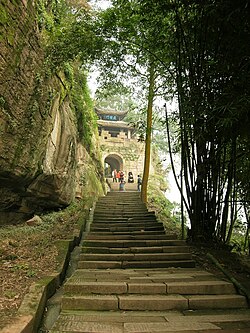
The Sichuan anti-Mongol fortresses are 83[1] mountain cities built by the soldiers and civilians of the Southern Song Dynasty during the Mongol conquest of China in Sichuan to resist the invasion of the Mongol Empire. Taking full advantage of the geographical advantages of the Sichuan Basin,[2] these fortresses formed a comprehensive three-dimensional defense system, which succeeded in resisting the Mongol attacks for up to 53 years, greatly extending the life of Southern Song. They also made Sichuan the last to be conquered by the Mongolians in 1288.[1][3] Due to the defense of the fortresses, it was difficult to settle the Sichuan region. The Mongol Army had to abort its original strategy of "taking Shu (Sichuan) and destroying Song" and moved to the area of Jingzhou and Xiangyang starting from 1271, defeating the Song Dynasty via the Han River.[4] Möngke Khan became the only Mongol khagan to perish on the battlefield when he died during an assault on Diaoyucheng in 1259.[5] He may have been a victim of dysentery or of injuries sustained when attacking the fortress.[6]
At present, there are still 48 fortresses kept to this date from the Song Dynasty in Sichuan and Chongqing. Among them, five of them (including Diaoyucheng and Baidicheng) were recognized as Major Historical and Cultural Sites Protected at the National Level. Another 14 of the fortresses were selected as major historical and cultural sites protected by Sichuan Province and Chongqing. But overall, except for a select few such as Diaoyucheng, most of them have not been effectively protected or developed.[7]
- ^ a b "崖山之後,還有凌霄!南宋凌霄城長寧軍扛起了宋人最後的戰旗" (in Chinese (Hong Kong)). Retrieved 2020-04-02.
- ^ 范晓 (2007年). "四川盆地的南宋城堡——红层方山上失落的古城要塞群". 中国国家地理 (第9期).
- ^ 赵尔阳 (2014年). "宋蒙(元)战争时期四川军事地理初步研究". 西南大学.
- ^ 薛玉树 (1993年). "宋元战争中四川的宋军山城及其现状". 四川文物 (第1期).
- ^ 孟銓; 潘朝陽 (1978). 開國英雄傳 (in Chinese (Taiwan)). 莊嚴出版社.
- ^ "帝国的极盛:蒙哥汗时期,1251—1259年_剑桥中国辽西夏金元史_国学导航". www.guoxue123.com. Retrieved 2020-04-02.
- ^ 朱雪黎 (23 May 2014). "30座宋元古城藏在巴山蜀水间". 四川日报. Retrieved 2014-12-31.